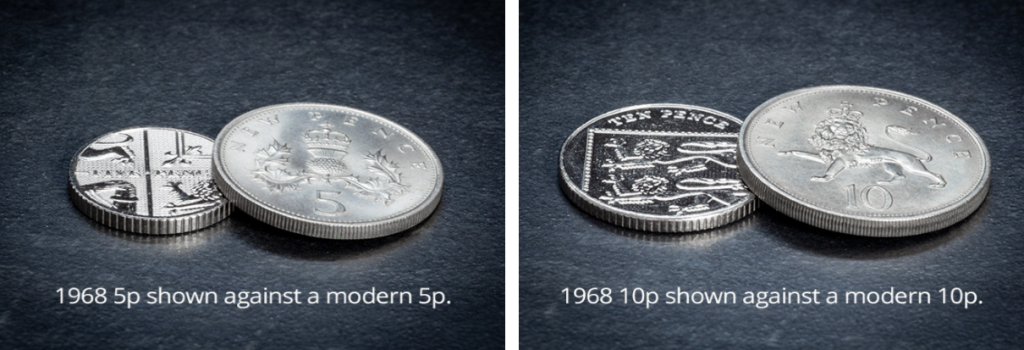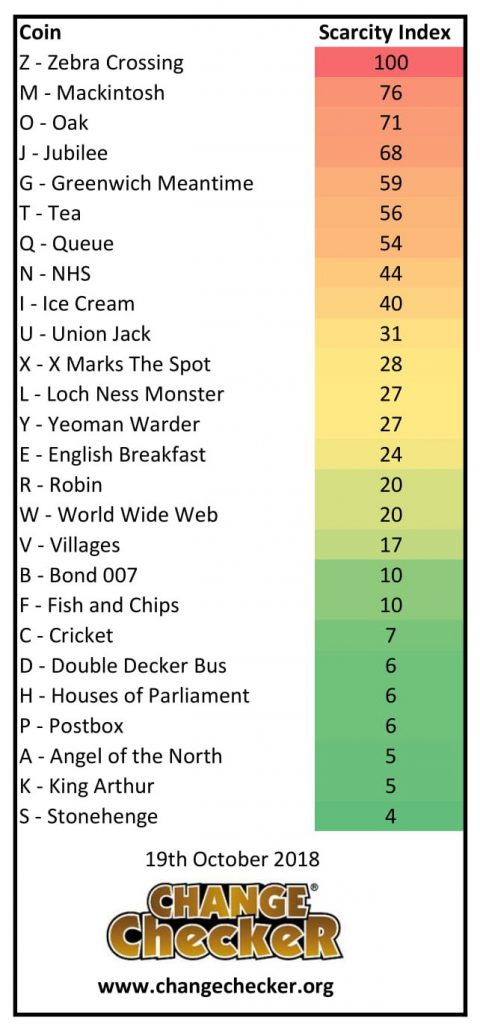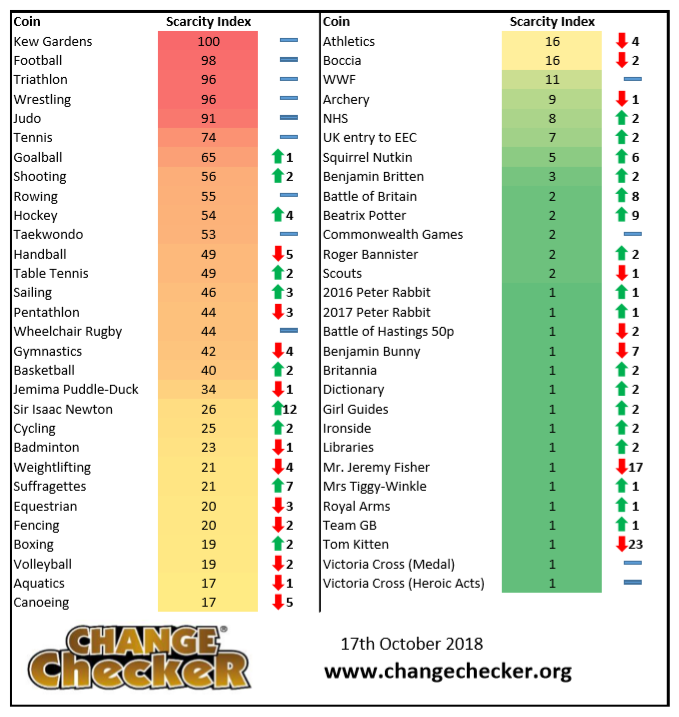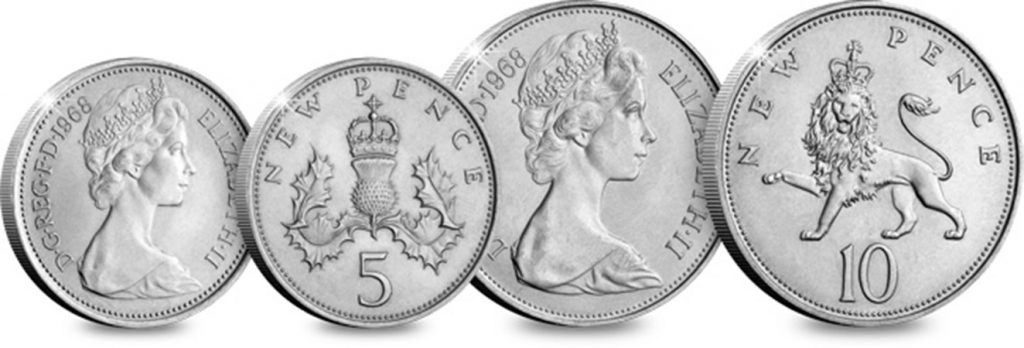50 years since the most important moment in British numismatic history…
2018 marks the 50th anniversary of arguably the most important moment in British numismatic history – the first coins issued for decimalisation.
In 1968, the British public would have found 5p and 10p coins in their change for the very first time, issued as part of Britain’s conversion to a system of decimal currency.

1968 5p and 10p coins
The coins bore new heraldic designs, but were exactly the same size and value as shillings and florins, which meant the changeover process should have been a smooth transition. However, after generations of pounds, shillings and pence, the Decimal Currency Board still needed to reassure suspicious Britons to go decimal – a case which had actually been argued as long ago as 1696 by Sir Christopher Wren.

Advert from the Decimal Currency Board. Credit: Daily Mail
It was the 1960 report by the Association of British Chambers of Commerce and the British Association for the Advancement of Science which finally set into action a currency based upon simple multiples, a system already adopted by a number of Commonwealth countries including Australia, New Zealand and South Africa.
A massive number of coins were required for the changeover, forcing The Royal Mint to move location from Tower Hill to its new production facility in Llantrisant, South Wales, where the first of almost six billion coins required for decimalisation went into production.

The Royal Mint at Tower Hill, London. Credit: The Royal Mint museum
It was then on the 23rd April 1968 that the new 5p and 10p coins went into circulation, operating as legal tender up to the sum of £5, with mintage figures of 98,868,250 and 336,143,250 respectively.
The humble 5p featured the Christopher Ironside reverse design until 2008 and has since featured Matthew Dent’s reverse design, following a public competition held by The Royal Mint. On the 27th June 1990, a reduced size version of the coin was introduced and the older, larger coins were withdrawn on the 31st December 1990, although the design remained unchanged.
Similarly, the 10p coin also featured Christopher Ironside’s reverse design up until 2008 when this was replaced by Matthew Dent’s. However, the 10p remained a larger coin until the 30th September 1992, when the reduced size version was introduced, with the larger coin being removed from circulation a year later.

As we seem to move ever closer towards a cashless society, the questions lingers as to how long these decimalised coins will remain a necessity… However, this year’s release of 26 brand new A-Z of Great Britain 10p coin designs just goes to show that the demand for the smaller denomination coins is still there. In fact, these little coins have become incredibly sought-after and have dominated news stories and conversations amongst collectors, with everyone wanting to get their hands on the elusive coins!
Although the nation seemed reluctant to accept these decimal coins back in 1968, I think it’s fair to say that they have now become a much loved part of British coinage and as we celebrate the 50th anniversary of the first decimalised coins, we can look back with fondness for the 5p and 10p coins.
Own the very first coins issued for decimalisation!
The First Decimalised Coins include the original 5p and 10p coins from their first year of issue, 1968.
Order yours today to mark the 50th anniversary of the introduction of these significant coins >>
The FIRST EVER A-Z 10p Scarcity Index!
The latest Change Checker Scarcity Index update of 2018 is here and excitingly, we have now been able to put together our first ever A-Z 10p Scarcity Index!
This information has been compiled using data from the third quarter of the year and presented in the easy to use indexes below to help you track the performance of your coins.
FIRST EVER A to Z 10p Scarcity Index
As more coins are starting to appear in circulation and Change Checkers are adding them to their collection, we are now able to use this data to put together the very first A-Z 10p Scarcity Index.

Initially, 2.6 million A-Z 10p coins were released, however recent news has revealed that another 2.6 million coins have now entered circulation! Therefore, we have estimated a mintage figure of 200,000 for each design in order to put together this index, combining mintage figures with the number of each coin listed in Change Checker’s collections and the number of each coin requested to swap by Change Checkers.
The clear front runner is Z -Zebra Crossing, sitting 24 points ahead of the second place coin, M – Mackintosh. Whilst everyone seems to be struggling to find the A-Z 10ps, these top few coins appear to be the hardest to come across so far, whereas S – Stonehenge, K – King Arthur and A – Angel of the North seem to be the most common. A – Angel of the North was actually the top design for the A-Z 10p Swap Index, suggesting it is most popular and therefore being swapped more often if people are finding multiples of this design.
It is only early days in terms of creating a fully accurate Scarcity Index for these coins, as we still await confirmed mintage figures for each design, and of course it is possible that this may change as more coins are found in circulation.
50p Scarcity Index

We’ve seen a lot of movement on the 50p index this quarter, possibly due to the high numbers of 2017 Beatrix Potter 50ps which have now entered circulation.
The Battle of Britain and 2016 Beatrix Potter 50p have both jumped up the index, but the most significant increase goes to the 2017 Sir Isaac Newton 50p, which actually has the second lowest mintage figure for any commemorative 50p in circulation. This coin has moved up 12 places this quarter, and I wouldn’t be surprised to see it continue to improve.
Of course, Kew Gardens still remains the most scarce UK 50p coin with a mintage figure of just 210,000 and in fact, our top 6 coins have remained consistent since last quarter.
£2 Scarcity Index
We’re still waiting on the 2017 WW1 Aviation and Jane Austen £2 coins to enter circulation, and so there hasn’t been much movement for the £2 index this quarter.
The ever popular Commonwealth Games £2 coins remain at the top, although Wales has now moved down to become the least popular of the four. Our final 8 remain consistent and the only major movement goes to the Wireless Transmission £2 coin, which has fallen 7 places down the index.
We’re eagerly awaiting the newer coins to enter circulation, which I’m sure will then cause a significant re-shuffle of the leaderboard!
How the Scarcity Index works
Generally collectors have had to rely upon mintage figures to identify the scarcest coins. But they only tell part of the story. Trying to find a good quality coin from 15 – 20 years ago, even for a higher mintage issue, is much more challenging than a more recent issue, as coins become damaged over time and are ultimately removed from circulation.
Additionally, some designs are more hoarded than others by people who might not normally collect coins – the poignant First World War £2 Coin series being an example. Finally, it can be up to a couple of years before the Royal Mint eventually confirms the actual mintage for an issue.
That’s why we have combined the mintage information with two other key pieces of information.
- How many of each design are listed as “collected” by Change Checkers, indicating the relative ease of finding a particular coin.
- The number of times a design has been requested as a swap over the previous 3 months, showing the current level of collector demand.
Importantly, as new coins are released and popularity rises and falls across different designs the Scarcity Index will be updated quarterly allowing Change Checkers to track the relative performance of the UK’s circulation coins.
How much are my coins worth?
The Scarcity Index does not necessarily equate to value but it is certainly an effective indicator. For example, the Kew Gardens 50p coin commands a premium of up to 160 times face value on eBay.
What about £1 Coins?
The £1 Scarcity Index has already been published for the Round £1 coins and, because they are no longer being issued, this is now set in stone.
If you’re interested in coin collecting, our Change Checker web app is completely free to use and allows users to:
– Find and identify the coins in their pocket
– Collect and track the coins they have
– Swap their spare coins with other Change Checkers
Sign up today at: www.changechecker.org/app
The Allied Nations join forces once again to mark the Armistice Centenary
On the eleventh hour of the eleventh day of the eleventh month in 1918, the guns fell silent – the war in Europe was over.
2018 marked 100 years since this pivotal moment, and to mark the centenary year, many of the allied nations joined forces again to issue special commemorative coins. Let’s take a look at some of the coins released from around the world, including Canada, New Zealand, Australia, France and of course the UK.
2018 UK Armistice £2

This £2 was the final coin in the First World War £2 series, first issued by The Royal Mint in 2014. The design, by Stephen Raw, features the words ‘The truth untold, the pity of war’, from the Wilfred Owen poem Strange Meeting. The words stand out of a mud-like background in the centre of this striking £2 coin, which was actually modelled in the clay taken by the artist from the Sambre-Oise Canal, where Wilfred Owen died in 1918.
2018 UK Remembrance £5

To honour the sacrifices of all those who have risked and continue to risk their lives to protect our freedom, this UK £5 coin was issued by The Royal Mint in 2018. The coin features a design by Laura Clancy on the reverse symbolic of the resilient and determined poppies that grew amidst the chaos in the valley of the Somme and colour printing to highlight the vibrant red in the poppy design. This coin stands as a poignant reminder of the brave men and women who have lost their lives or have been injured in conflicts past and present.
Isle of Man First World War Centenary 50p

This 50p was chosen by the Isle of Man Government to commemorate the First World War Armistice Centenary. As a special acknowledgement to the sacrifices made by the 1,165 Manx men who lost their lives in the war, a specially minted coin featuring distinctive red poppies was presented to each child in full time education on the Isle of Man. Cupro-Nickel versions of the coin without the red poppies went into general circulation. The coin features ‘The Manxman’ from the top of the Douglas War Memorial, the words ‘Their name liveth for evermore’ and the Roman numerals ‘XI.XI.XI’ meaning 11.11.11.
2018 Canada Armistice $2

In October 2018, The Royal Canadian Mint unveiled these finely crafted $2 coins, issued to remember the sacrifices of Canadians who fought for freedom during WWI.
Just 3 million coins were minted – two million of a stunning coloured version and one million of the non-coloured coin – both of which were released into circulation in Canada. The reverse image by artist Laurie McGaw features a soldier’s helmet in the centre to represent the many lives lost during WWI, and the large poppy beneath it is inspired by the Canadian poem In Flanders Fields by John McCrae, who died in combat in January 1918.
2018 US World War 1 Centennial Dollar

Credit: usmint.gov
More than 4 million men and women from the United States served in the First World War and so to commemorate the centenary and honour the American soldiers, this Proof Silver Dollar was issued. The obverse design is titled “Soldier’s Charge” and depicts a soldier gripping his rifle, with the words, “LIBERTY,” “1918,” and “IN GOD WE TRUST.” The reverse design is titled “Poppies in the Wire,” featuring poppies mixed amongst brutal barbed wiring.
2018 New Zealand Armistice 50 Cent

The 2018 New Zealand Armistice 50 cent coin followed the Anzac coin, which was minted in 2015 to mark the centenary of New Zealand’s efforts in WW1. Designed by Dave Burke, the reverse of this 50 Cent features a coloured red poppy flower surrounded by a wreath, and the three silver ferns on the wreath represent the three services of the New Zealand Defence Force – Army, Navy and Air Force. The 50-cent coins were released into circulation in New Zealand in October 2018, but were actually struck by The Royal Canadian Mint, where all 10, 20 and 50 cent coins were minted for New Zealand in 2018.
2018 Australia Armistice $2

The Royal Australian Mint issued this $2 Armistice coin to serve as a tangible and visible reminder to all Australians of the fight for freedom during WWI. Designed by T Dean and developed with the assistance of the Australian War Memorial, the coin features the number 100 to signify the important Armistice Centenary Anniversary, and the centre zero features a red coloured poppy. The coin features a ‘C’ mintmark, meaning the it was struck at the Canberra Mint.
2018 France Armistice €2

Issued by La Monnaie de Paris (The Paris Mint), this €2 coin features a cornflower, a symbol of remembrance in France. This dates back to WWI as soldier’s uniforms were blue and these flowers, as well as poppies, continued to grow in land devastated by war. The flower also symbolizes delicacy and innocence.
2018 Hungary HUF 2,000

Credit: www.mnb.hu
The Magyar Nemzeti Bank in Hungary paid homage to the heroic efforts and the sacrifice made by Hungarian soldiers by issuing a 2,000 HUF collector coin. The dominant design featured on the obverse shows a section of a world map with Europe as the centre and starred settlement names in boxes where the most significant battles took place involving Hungarian soldiers. The reverse depicts a scene from the trenches, showing trench warfare and the tragedy of war, as well as the heroism and comradery of the soldiers.
Solomon Islands $1

Credit: www.bnt.org.uk
The Solomon Islands issued this limited edition 1 dollar coin featuring a cluster of vivid red Remembrance poppies against the Union Flag background. The reverse design has the important centenary dates and the words ‘LEST WE FORGET’. As the Solomon Islands is a commonwealth country, the reverse of this coin featured Queen Elizabeth II’s portrait.
Each coin pays its own historic tribute to this significant anniversary marked by millions of people around the world.
Do you have a favourite Armistice coin from around the world? Let us know in the comments!



